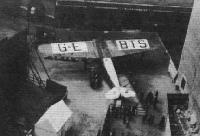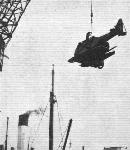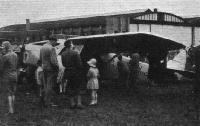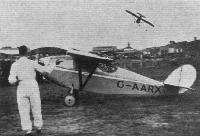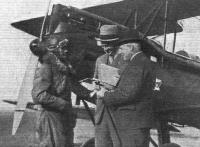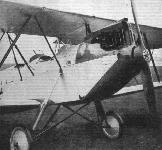Фотографии
-
AT MILAN AERO SHOW: The combined exhibit of Isotta Fraschini, S.I.S.A. (the Savoia 55 flying-boat), and S.A.M. Air Lines.
Самолёты на фотографии: Savoia-Marchetti / SIAI S.55 - Италия - 1924
-
Регистрационный номер: G-EBTS, H-NADK "STRANDED": An aerial view (from Bush House) of the "Spider" which was exhibited all last week in the Strand by Shell Mex, Ltd.
Самолёты на фотографии: Fokker F.VII / C-2 / F.XIV - Нидерланды - 1924
-
SCHNEIDER TROPHY WINNER IN THE AIR AGAIN: The Supermarine-Rolls-Royce "S.6" seaplane, which won the Schneider Trophy last year, being shipped at Southampton en route for the Antwerp Exhibition, where, by permission of the Air Ministry, it will form one of the most important exhibits of the British Section.
Самолёты на фотографии: Supermarine S.5 / S.6 - Великобритания - 1927
-
A NEW VENTURE: Capt. Stack standing alongside his "Hermes-Moth," the property of S. Smith and Sons for whom he is now flying.
Самолёты на фотографии: De Havilland Moth / D.H.60 - Великобритания - 1925
-
Регистрационный номер: G-AAAH At Jhansi: An officer helps to start Miss Johnson's engine.
Самолёты на фотографии: De Havilland Moth / D.H.60 - Великобритания - 1925
-
Регистрационный номер: X4N Packard Diesel engine installed in Waco machine.
Самолёты на фотографии: WACO 10 / O Series - США - 1927
-
A Boeing 3-engined (525 h.p. Pratt & Whitney "Hornet") cabin 'plane employed on the Chicago-San Francisco air service. It has accomodation for 18 passengers. As will be seen, these machines have to fly over mountain range on certain sections of the route.
Самолёты на фотографии: Boeing Model 80 - США - 1928
-
Регистрационный номер: G-AAUA THE LATEST "AUTOGIRO": Fitted with an Armstrong-Siddeley "Genet Major" engine, this machine is characterised by a rotor of somewhat different design, with larger blades and lower speed. The performance has improved in various respects, and altogether this latest type is said to mark yet another step forward in the evolution of a very interesting aircraft type.
Самолёты на фотографии: Cierva/Avro C.19 - Великобритания - 1929
-
The "Late 28-3" seaplane which will be used on the South Atlantic section of the France-South America air service.
Самолёты на фотографии: Latecoere L.28 - Франция - 1929
-
Front and flying views of the "Late 28-3" seaplane.
Самолёты на фотографии: Latecoere L.28 - Франция - 1929
-
A NEW FOCKE-WULF "ENTE": The latest model, flown for the first time the other day, resembles the previous machine, but the addition of outboard wing rudders will be noted.
Самолёты на фотографии: Focke-Wulf F 19 Ente - Германия - 1927
-
THE PRINCE OF WALES ARRIVES BY AIR AT WINDSOR: The Prince flew from Marseilles in a Westland "Wapiti," piloted by Sqdn.-Ldr. Don, which is seen in the centre of our picture, the Prince being in the group standing by the car on the right.
Самолёты на фотографии: Westland Wapiti - Великобритания - 1927
-
THE "AVRO TRAINER": Three-quarter Front View. The Fabric Fairings are made as detachable units to facilitate inspection of the Fuselage Structure.
Самолёты на фотографии: Avro Tutor/Sea Tutor/Prefect / Type 621/646/626 - Великобритания - 1929
-
The Skeleton of the "Avro Trainer." Nose, showing Engine Mounting, etc
Самолёты на фотографии: Avro Tutor/Sea Tutor/Prefect / Type 621/646/626 - Великобритания - 1929
-
THE "AVRO TRAINER": The front view gives a good idea of the wide track of the undercarriage.
Самолёты на фотографии: Avro Tutor/Sea Tutor/Prefect / Type 621/646/626 - Великобритания - 1929
-
THE "AVRO TRAINER": In this three-quarter rear view, possibility of jumping by parachute from either cockpit is well brought out.
Самолёты на фотографии: Avro Tutor/Sea Tutor/Prefect / Type 621/646/626 - Великобритания - 1929
-
THE "AVRO TRAINER": The machine in flight.
Самолёты на фотографии: Avro Tutor/Sea Tutor/Prefect / Type 621/646/626 - Великобритания - 1929
-
The "Avro Trainer" in flight at Woodford Aerodrome.
Самолёты на фотографии: Avro Tutor/Sea Tutor/Prefect / Type 621/646/626 - Великобритания - 1929
-
Welded steel tube construction is employed in the tail unit of the "Avro Trainer." The tail skid is a leaf spring, carrying a chilled cast-iron shoe.
Самолёты на фотографии: Avro Tutor/Sea Tutor/Prefect / Type 621/646/626 - Великобритания - 1929
-
The Nose of the "Avro Trainer" fitted with "Mongoose" engine.
Самолёты на фотографии: Avro Tutor/Sea Tutor/Prefect / Type 621/646/626 - Великобритания - 1929
-
An alternative power plant. The "Avro Trainer" fitted with "Lynx" engine.
Самолёты на фотографии: Avro Tutor/Sea Tutor/Prefect / Type 621/646/626 - Великобритания - 1929
-
THE "AVRO TRAINER": This part-sectioned Side Elevation shows the general characteristics of the structure and the placing of seats, etc.
Самолёты на фотографии: Avro Tutor/Sea Tutor/Prefect / Type 621/646/626 - Великобритания - 1929
-
THE "AVRO TRAINER": Some constructional details of the fuselage. The locations of the different joints, etc., are shown in the key diagram. Figs. 1 and 2 are "inside" and "outside" views of the cross-tube joint on lower longeron at point where wing spar is attached. The cross-tube is reinforced internally. Fig. 3 shows a "Y" joint, formed by giving the main tube a "nick," bending and welding it, and welding to the joint a second tube to steady the first at the bend. Another welded joint is shown in 4. Figs. 5 and 6 show the lug (forging) by means of which the lower wing spars are attached to the lower longeron. This lug is attached to joints shown in 1 and 2. The joint at the top front corner of the fuselage is illustrated in 7. The fireproof bulkhead and engine mounting is attached here. The telescopic leg of the undercarriage is attached to the point of intersection of two crossed tubes, by the form of lug shown in 8, the top of the undercarriage leg itself being shown in 9. On the bottom cross-tube in the front of the fuselage the apices of no less than three vees meet in a welded joint as shown in 10.
Самолёты на фотографии: Avro Tutor/Sea Tutor/Prefect / Type 621/646/626 - Великобритания - 1929
-
MORE "AVRO TRAINER" FUSELAGE DETAILS: 11, 12, and 13 are dissected views of the sternpost, which is formed by two vertical tubes. The upper fitting for the tail trimming gear worm and wheel is shown in 11, and the lower, welded-on bracket at 12. To the ends of the longerons are welded split collars which carry the fin post, as shown in 13. The rudder is hinged to the fin post and carried on ball bearings. The casings over these bearings contain shaped felt pads soaked in lubricant. The wooden fairings are attached to the longerons by neat clips, as shown in 14. The Duralumin floor of the cockpit is supported as in 15. Lighter controls such as throttles, tail trimming gear, etc., are mounted on the fuselage tubes by a neat clip like that illustrated in 16.
Самолёты на фотографии: Avro Tutor/Sea Tutor/Prefect / Type 621/646/626 - Великобритания - 1929
-
THE "AVRO TRAINER": Some wing details. The rib construction is illustrated in 17. A main spar section is shown in 18. Note the flattened tube and aluminium block reinforcement of the spar booms for attachment of interplane strut fittings. Further details of this are also shown in 21 and 22. In Fig. 20 is shown one of the jigs used while riveting up the spars.
Самолёты на фотографии: Avro Tutor/Sea Tutor/Prefect / Type 621/646/626 - Великобритания - 1929
-
"Avro Trainer" Armstrong Siddeley "Mongoose" Engine
Самолёты на фотографии: Avro Tutor/Sea Tutor/Prefect / Type 621/646/626 - Великобритания - 1929
-
Mr. John Rogers gives a display of slow flying on the Salmson-engined Klemm monoplane.
Самолёты на фотографии: Klemm L.25 - L.28 Swallow - Германия - 1927
-
KLEMM TYPES: The new Siemens - Klemm belonging to Mr. R. Denman
Самолёты на фотографии: Klemm L.25 - L.28 Swallow - Германия - 1927
-
KLEMM TYPES: A Klemm with a Cirrus III.
Самолёты на фотографии: Klemm L.25 - L.28 Swallow - Германия - 1927
-
KLEMM TYPES: The nose of the new Siemens - Klemm belonging to Mr. R. Denman
Самолёты на фотографии: Klemm L.25 - L.28 Swallow - Германия - 1927
-
AT MILAN AERO SHOW: The Caproni stand, with the "Ca.101," 12-seater three-engined monoplane and the "100 T" light biplane;
Самолёты на фотографии: Caproni Ca.100 Caproncino - Италия - 1929Caproni Ca.101 - Италия - 1930
-
Регистрационный номер: G-AAVB "PUSS IN BOOTS": The De Havilland "Puss Moth" (Moth Three) with inverted "Gipsy III" engine, has now been put on floats. Last week one of these machines was flown from Rochester to the Welsh Harp by Capt. Broad. The floats have been made by Short Brothers.
Самолёты на фотографии: De Havilland Puss Moth / D.H.80 - Великобритания - 1929
-
Регистрационный номер: G-AAXJ, VT-ACZ IN PRODUCTION: Many visitors were interested in the new D.H. "Puss Moth," shown in the machine park.
Самолёты на фотографии: De Havilland Puss Moth / D.H.80 - Великобритания - 1929
-
Самолёты на фотографии: Caudron G.3 - Франция - 1913
-
Регистрационный номер: G-AAEY, J7557 DIGNITY AND IMPUDENCE: The Gadfly goes to bed beneath the nose of the Inflexible!
Самолёты на фотографии: Beardmore Inflexible - Великобритания - 1928Henderson & Glenny HSF.2 Gadfly - Великобритания - 1929
-
Packard Diesel engine installed in Stinson machine.
Самолёты на фотографии: Stinson Detroiter / Junior - США - 1927
-
Регистрационный номер: CF-ACU, CF-AHC AIR TRANSPORT AND MINING: We reproduce here a snapshot received from a Canadian reader, showing two Stinson Detroiters and a Fairchild 71 (CF-AHC) belonging to the Consolidated Mining Co. of Canada, Ltd., at their winter base, Prince Albert, on the Saskatchewan river.
Самолёты на фотографии: Fairchild Model 71 - США - 1928Stinson Detroiter / Junior - США - 1927
-
WELL EQUIPPED "AVIANS": A group of five "Avians" equipped with Goodyear Air-wheels and Handley-Page slots, ready for delivery by the Ottawa Car Co., the Canadian licensees for A. V. Roe, Ltd.
Самолёты на фотографии: Avro Avian / Type 594/616 - Великобритания - 1926
-
A "NEW NOTE" IN BRITISH AIRCRAFT DESIGN: The "Meteor," just completed at the Cowes works of Saunders-Roe, owes its inception to Sir Henry Segrave. It is a four-seater monoplane fitted with two "Gipsy III" engines. The first machine is of all-wood construction, but subsequent ones will have metal fuselages. Clean aerodynamic design has been one of the objects, as well as a high performance.
Самолёты на фотографии: Blackburn Segrave Meteor / B-1 - Великобритания - 1930
-
Регистрационный номер: G-AATS Самолёты на фотографии: Blackburn Bluebird / L.1 - Великобритания - 1924
-
Регистрационный номер: G-AAUF INVERTED DESCENDING! Mr. John Tranum makes a well-timed shot for the centre of the aerodrome at Sherburn.
Самолёты на фотографии: Blackburn Bluebird / L.1 - Великобритания - 1924
-
ENTERPRISE! Auto-Auctions, Ltd., the Bluebird agents, have fitted this Machine with the new Goodyear Air Wheels.
Самолёты на фотографии: Blackburn Bluebird / L.1 - Великобритания - 1924
-
HATCHING BLUEBIRDS: Our picture shows a batch of Blackburn "Bluebirds" coming through the Saunders-Roe works at Cowes. These machines are equipped either with "Cirrus" or "Gipsy" engines - that nearest the camera having the latter.
Самолёты на фотографии: Blackburn Bluebird / L.1 - Великобритания - 1924
-
Регистрационный номер: G-AARX Flying Officer Snaith, on the Comper "Swift" taxying into the machine park after giving an excellent display of flying (as seen above).
Самолёты на фотографии: Comper Swift / CLA.7 - Великобритания - 1930
-
THE FLEET ABOVE: A Fairey Flycatcher (Jaguar engine) flying over Malta. Below can be seen the hangars of the seaplane station.
Самолёты на фотографии: Fairey Flycatcher - Великобритания - 1922
-
These three photographs also form a series, and are arranged to show the process of getting the aircraft down by the lift. These lifts are situated one forward and one aft of the flying deck, and are large enough to take the III F when the wings are half folded. The fighters can, of course, be lowered as they are, owing to their comparatively small span. The top photograph shows the Flycatcher being wheeled on to the lift. It should be noted that the wind-screens are raised both at the side and in the front. These screens are raised when the wind interferes with such work on the flying deck, and are lowered again when flying continues. In the second picture, the lift has gone down a little, and the size of the platform can be seen. The bottom photograph was taken from between decks, and shows the lift about half-way down with a Flycatcher on it coming down. Beneath the lift, and forward of it, are other machines of the flight which have already been housed in the hangar.
Самолёты на фотографии: Fairey Flycatcher - Великобритания - 1922
-
A Flycatcher taking off from the flying deck, just as it has cleared the forward windscreen, which can now be seen laid prone, and flush with the deck, thus allowing the aircraft to take off over it without damage to their wheels. Another point to notice in this photograph is the steam jet. This jet comes from a steam pipe which opens right in the bows of the ship, and it serves to tell the navigator when the ship is heading directly into wind; this he does by altering course until the steam is going aft over the deck parallel to the landing lines.
Самолёты на фотографии: Fairey Flycatcher - Великобритания - 1922
-
A Flycatcher is taking off
Самолёты на фотографии: Fairey Flycatcher - Великобритания - 1922
-
A further selection from a cinema film, in this case showing a Flycatcher which landed and then got caught in a gust and slewed toward the ship's side before the landing crew had time to catch it; it was then righted, wheeled forward to the lift and sent down.
Самолёты на фотографии: Fairey Flycatcher - Великобритания - 1922
-
Регистрационный номер: S1280 A Flycatcher just emerging from the upper hangar and starting to fly off. The distance required to take off can be gauged from the fact that in the top photograph the aircraft is just reaching the wind screen, while in the lower picture she has already well cleared it. When taking off in this fashion, the engines are, of course, run up in the hangar while the mechanics hold the aircraft back.
Самолёты на фотографии: Fairey Flycatcher - Великобритания - 1922
-
A view taken from the bridge, of a Fairey III F just landing on the deck. Astern is the destroyer which always stands by when any flying is in progress; at the side of the deck can be seen the aerial masts now in the lowered position, and also the landing crew standing on the platforms at the side of the deck ready to jump up and hold on to the machine as soon as she comes level with them. In front of the aircraft are the white guiding lines on the deck between which it is always endeavoured to land, and thereby ensure that the best use is made of the width of the deck and also minimise the danger of going overboard or hitting the funnel.
Самолёты на фотографии: Fairey Fairey IIIF - Великобритания - 1926
-
A III F is landing.
Самолёты на фотографии: Fairey Fairey IIIF - Великобритания - 1926
-
The series is taken from a cinema film, and are really self-explanatory. The Fairey III F can be seen approaching and finally landing.
Самолёты на фотографии: Fairey Fairey IIIF - Великобритания - 1926
-
COMMERCIAL PRODUCTION: A batch of Desoutter cabin aircraft ready for delivery at Croydon.
Самолёты на фотографии: Koolhoven FK-41 - Нидерланды - 1928
-
Регистрационный номер: G-AAWT, PK-SAN COMMERCIAL ENTERPRISE: The Desoutter (Hermes) recently delivered to Cirrus Engines, Ltd. This will enable Mr. V. Holman, sales manager, to keep in better touch with all the firm's customers. Mr. V. Holman, who is an experienced pilot, will fly the machine himself.
Самолёты на фотографии: Koolhoven FK-41 - Нидерланды - 1928
-
Регистрационный номер: G-AAIP We show a selection of views of Mr. Norman Holden's "Cutty Sark." The clear view forward from the cabin can be seen, as also the wide track of the undercarriage. On the right is Mr. Holden, Mrs. Holden and Mr. E. Hordern (pilot).
Самолёты на фотографии: Saunders-Roe Cutty Sark / A.17 - Великобритания - 1929
-
Регистрационный номер: PH-AGA [4] THE FOKKER F.IX. This machine has recently been put on the England-Holland service by the K.L.M.
Самолёты на фотографии: Fokker F.IX / F.XII / F.XVIII - Нидерланды - 1929
-
Регистрационный номер: PH-AGA [4] Three-quarter rear view of the Fokker F.IX.
Самолёты на фотографии: Fokker F.IX / F.XII / F.XVIII - Нидерланды - 1929
-
Регистрационный номер: PH-AGA [4] Nose of the F.IX.: The engines are "Jupiters" of 500 h.p. each. Note the windows around the pilot's cockpit, which give protection without loss of view. The undercarriage is of the usual Fokker type, with numerous endless rubber rings as the shock-absorbing medium. Wheel brakes are fitted.
Самолёты на фотографии: Fokker F.IX / F.XII / F.XVIII - Нидерланды - 1929
-
Регистрационный номер: PH-AGA [4] The illustration shows the F.IX. in three-quarter front view. The people walking about near the machine give a good idea of the size.
Самолёты на фотографии: Fokker F.IX / F.XII / F.XVIII - Нидерланды - 1929
-
A view into the luggage compartment, which is exceptionally roomy.
Самолёты на фотографии: Fokker F.IX / F.XII / F.XVIII - Нидерланды - 1929
-
COMFORTABLE FLYING: The passenger cabin of the latest type of machine, Fokker F.IX with 3 Bristol "Jupiter" engines, to be put into service by the K.L.M., line has ample leg and elbow room. The leather-upholstered chairs are provided with adjustable head rests, so that passengers can change their position to the most comfortable.
Самолёты на фотографии: Fokker F.IX / F.XII / F.XVIII - Нидерланды - 1929
-
Регистрационный номер: N227 [2] THE GLOSTER "GNATSNAPPER": This is a Single-seater Fleet Fighter, fitted with Armstrong Siddeley "Jaguar VIII" Engine. The pilot on the occasion when these photographs were taken was Flying Officer H. J. T. Saint, D.S.C., Gloster's Chief Test Pilot.
Самолёты на фотографии: Gloster Gnatsnapper - Великобритания - 1928
-
Регистрационный номер: N227 [2] Самолёты на фотографии: Gloster Gnatsnapper - Великобритания - 1928
-
Flt.-Lt. Stainforth gives a demonstration of Joystick Jerks on a Junkers ''Junior.''
Самолёты на фотографии: Junkers A 50 Junior - Германия - 1929
-
THE AIRCRAFT CARRIER IN AUSTRALIA: A Flight of Supermarine - Napier "Seagulls" of the Royal Australian Air Force flying over their Carrier, the "Albatross."
Самолёты на фотографии: Supermarine Seal / Seagull - Великобритания - 1921
-
Регистрационный номер: CH-185 WE show in the accompanying illustrations two views of a new Swiss light 'plane, the "Korsa T2," constructed by Hugo G. Schmid at the Korsa works at Altstetten, Zurich. The forerunner of this neat little 'bus, "Korsa 1" (which was described in FLIGHT for April 5, 1928) was destroyed on its first flight, so a model was made and tested in the Mind tunnel at Goettingen. The tests were so promising that "Korsa T2" was built, and Mr. Schmid has already flown it for more than 50 hours with excellent results.
Самолёты на фотографии: Korsa T.1 / T.2 - Швейцария - 1927
-
A SPARTAN SPARTAN: The first Spartan to be fitted with skis, in Norway.
Самолёты на фотографии: Simmonds Spartan - Великобритания - 1928
-
AT MILAN AERO SHOW: The Breda stand. Here was the very neat "Breda 15" light seaplane.
Самолёты на фотографии: Breda Ba.15 - Италия - 1928
-
Mr. and Mrs. Norman are receiving a glass of "Vin d'honneur" from the officials on their arrival.
Самолёты на фотографии: De Havilland Moth Coupe - Великобритания - 1928
-
Miss Amy Johnson, of Hull, who left Croydon on May 5 for Australia, piloting a D.H. "Gipsy-Moth." Miss Johnson, who is the only woman to hold an Air Ministry ground engineer's licence, hopes to beat Bert Hinkler's record of 15 1/2 days for the journey.
Самолёты на фотографии: De Havilland Gipsy Moth / Moth X - Великобритания - 1928
-
A SHELL MOTH IN AUSTRALIA: F/O. Owen hands over the log books of the Shell Go.'s new Moth to the General Manager, Mr. O. Darch.
Самолёты на фотографии: De Havilland Gipsy Moth / Moth X - Великобритания - 1928
-
Регистрационный номер: G-AAAA Mr. and Mrs. Ivor McClure, who arrived in their newly-acquired Moth G-AAAA
Самолёты на фотографии: De Havilland Gipsy Moth / Moth X - Великобритания - 1928
-
Регистрационный номер: G-AAWK [5] Side and three-quarter rear views of the D.W.2.
Самолёты на фотографии: Dudley Watt D.W.2 - Великобритания - 1930
-
Регистрационный номер: G-AAWK [5] Mr. Dudley Watt demonstrates his new training 'bus, the "D.W.2."
Самолёты на фотографии: Dudley Watt D.W.2 - Великобритания - 1930
-
Регистрационный номер: G-AAWK [5] Самолёты на фотографии: Dudley Watt D.W.2 - Великобритания - 1930
-
Регистрационный номер: G-AAWK [5] The Tail Surfaces of the D.W.2 are of generous proportions.
Самолёты на фотографии: Dudley Watt D.W.2 - Великобритания - 1930
-
Регистрационный номер: G-AAWK [5] Forward portion of the D.W.2, showing engine and undercarriage
Самолёты на фотографии: Dudley Watt D.W.2 - Великобритания - 1930
-
The wing construction of the D.W.2 is very simple. Note that the spar depth is smaller than the overall rib depth.
Самолёты на фотографии: Dudley Watt D.W.2 - Великобритания - 1930
-
THE D.W.2: On the left, a general sketch showing wing construction. On the right, one of the interplane strut fittings on the main spars.
Самолёты на фотографии: Dudley Watt D.W.2 - Великобритания - 1930
-
The fuselage of the D.W.2 has plywood covering on sides and bottom, and a fabric-covered fairing on top,
Самолёты на фотографии: Dudley Watt D.W.2 - Великобритания - 1930
-
On the left is shown the fitting on the fuselage which takes the telescopic leg of the undercarriage and the forward centre-section strut. On the right are shown the two types of spar end fittings used.
Самолёты на фотографии: Dudley Watt D.W.2 - Великобритания - 1930
-
D.W.2 Cirrus III Engine
Самолёты на фотографии: Dudley Watt D.W.2 - Великобритания - 1930
-
THE PRUFLING: Mr. Alan Goodfellow flying the Lancashire Club's new glider.
Самолёты на фотографии: Lippisch / RRG Prufling - Германия - 1926
-
A MIDLAND GLIDER: The Glider of the Midland Club about to be launched.
Самолёты на фотографии: Midland Gliding Club / Rushton glider - Великобритания - 1930
Статьи
- Flight

